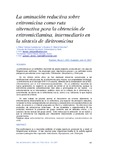| dc.contributor.author | Gómez Castellanos, José Rubén | |
| dc.contributor.author | Madrid Sánchez, Gustavo Alonso | |
| dc.creator | GOMEZ CASTELLANOS, JOSE RUBEN; 219442 | |
| dc.date.accessioned | 2019-02-28T03:20:34Z | |
| dc.date.issued | 2007-12 | |
| dc.identifier | http://repositorio.lasalle.mx/handle/lasalle/938 | |
| dc.identifier.citation | Gómez Castellanos, J. R. y Madrid Sánchez, G. A. (2007). La aminación reductiva sobre eritromicina como ruta alternativa para la obtención de eritromicilamina, intermediario en la síntesis de diritromicina. Revista del Centro de Investigación de la Universidad La Salle, 7(28), 41-48. | es_MX |
| dc.identifier.issn | 1665-8612 | |
| dc.identifier.other | https://doi.org/10.26457/recein.v7i28.222 | |
| dc.identifier.uri | http://revistasinvestigacion.lasalle.mx/index.php/recein/article/view/222/445 | |
| dc.description.abstract | La eritromicina es un antibiótico macrólido de amplio espectro, producido por una cepa de Streptomyces erythreus. Ha alcanzado gran importancia gracias a su actividad contra patógenos prevalentes como Legionella, Helliobacter, Micoplasma y Chlamydia. En los últimos veinte años, se han dedicado esfuerzos sustanciales a las modificaciones estructurales de la eritromicina para mejorar sus propiedades biológicas. La diritromicina es el derivado 9-N-11-O-oxazina, obtenido de la condensación de la 9(S)-eritromicilamina con el 2-(2-metoxietoxi) acetaldehído. Es un antibiótico macrólido de nueva generación; su espectro de acción es similar al de la eritromicina, aunque la diritromicina presenta concentraciones más altas y prolongadas en los tejidos. La eritromicilamina es el intermediario sintético clave en la síntesis de la diritromicina y, comúnmente, se deriva de la eritromicina vía su oxima o su hidrazona lo que implica varios pasos de síntesis. En este trabajo se planteó acortar el mecanismo de síntesis obteniendo la eritromicilamina directamente de la vía eritromicia, una reacción de aminación reductiva, formando la imina correspondiente con amoniaco y reduciéndola con cianoborohidruro de sodio, de acuerdo a un método propuesto por Borch y colaboradores. Se obtuvieron dos productos, de extracciones ácido-base. Al ser sometidos a espectrometría IR los productos revelaron la presencia del grupo carbonilo que se deseaba aminar, y la ausencia de las bandas del grupo amino. Esto indica que la aminación no se realizó y que la eritromicina fue degrada por mecanismo desconocido a productos aún no caracterizados. | es_MX |
| dc.description.abstract | The erythromycin is a macrolide antibiotic of ample spectrum, produced by a stock of Streptomyces erythreus. It has reached great importance thanks to its activity against prevalent pathogens like Legionella, Helicobacter, Mycoplasma, and Chlamydia. In the last twenty years, the erythromycin has been committed with substantial efforts to improve its structural and biological properties. Dirithromycin is the 9N-11-O-oxazine derivative, obtained out of condensation of 9(S)-erythromycyclamine with the 2-(2-methoxyethoxy) acetaldehyde. It is a macrolide antibiotic of new generation; its spectrum of action is similar to that of erythromycin, although dirithromycin presents higher and more prolonged concentrations in the weaves. Erythromycyclamine is the synthetic intermediary key in the synthesis of dirithromycin and, commonly, derived from the eritromicina via oxime or his hydrazones implying several passages of synthesis. In this work, it was considered to shorten the synthesis mechanism obtaining erythromycyclamine directly via erythromycin, a reaction of reductive amination forming the corresponding amina with ammonia and reducing it with Sodium Cyanoborohydride, according to a method proposed by Borch and collaborators. Two products of acid-base extractions were obtained. When subject to IR spectrometry, they revealed the presence of the group carbonyl wanted to be amined, and the absence of the bands of the amino group. This indicates that the amination was not made and that the erythromycin was degraded by an unknown mechanism to products not characterized yet. | es_MX |
| dc.format | application/pdf | es_MX |
| dc.language.iso | spa | es_MX |
| dc.publisher | Universidad La Salle México, Dirección de Posgrado e Investigación | es_MX |
| dc.relation | http://revistasinvestigacion.lasalle.mx/index.php/recein/article/view/222/157 | |
| dc.rights | Acceso abierto | es_MX |
| dc.rights.uri | http://creativecommons.org/licenses/by-nc-nd/4.0 | * |
| dc.subject | Eritromicilamina | es_MX |
| dc.subject | Diritromicina | es_MX |
| dc.subject | Reducción aminativa | es_MX |
| dc.subject | Cianoborohidruro de sodio | es_MX |
| dc.subject | Erythromycyclamine | es_MX |
| dc.subject | Dirithromycin | es_MX |
| dc.subject | Reductive amination | es_MX |
| dc.subject | Sodium cyanoborohydride | es_MX |
| dc.subject.classification | MEDICINA Y CIENCIAS DE LA SALUD::CIENCIAS MÉDICAS::FARMACOLOGÍA | es_MX |
| dc.subject.other | Antibióticos macrolideos | es_MX |
| dc.title | La aminación reductiva sobre eritromicina como ruta alternativa para la obtención de eritromicilamina, intermediario en la síntesis de diritromicina | es_MX |
| dc.type | article | es_MX |
| dc.identificator | 3||32||3209 | es_MX |
| dc.audience | generalPublic | es_MX |







